Roli has debuted the Seaboard Rise, an expressive keyboard controller based on their ground-breaking Seaboard Grand. The Rise is a compact, 25-key version of the Grand, at a much more accessible price point. But don’t judge it on its diminutive size and lower price, the new Seaboard Rise eclipses the Grand in many arenas.

Although the UK company priced the Rise for the masses, they certainly didn’t skimp on ingenuity, build-quality or features. FutureMusic had an exclusive look at the Rise, prior to their international rollout, and tested the controller with five different reviewers, their impressions in quotes below. Not only did we put the Rise controller through its paces, but we also tested it with their new case, the Equator software synthesizer and the Noise iOS app.
» Five Dimensions Of Expression
» Two-Octave, 25 Keywave Control
» MIDI Over Bluetooth
» Internal Battery
» Equator Soft Synth
» Protective Case
» Noise iOS Companion App
» Optional FlipCase
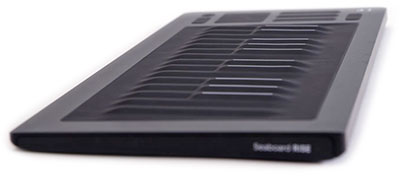
When the Roli Seaboard Grand, a provocative expressive controller, was announced last year for a substantial $4000, we thought: “How nice. Jordan Rudess must be psyched.” The reality was that only someone with Jordan’s chops, and the willingness to spend major bank, could drop this significant chunk of cash on a hand-built controller. Sure the Seaboard Grand was imaginative with dynamic expressive control way beyond pitch bend, modulation and aftertouch, but to think that this fabric-covered interface with bulbous, soft keys had much life beyond a boutique product was not giving enough credit to the team behind this pioneering concept.
Continuous Touch
What was so ingenious about the Grand was how they approached the challenge of providing additional expression. Unlike many other new controller/instrument paradigms that have entered the market, Roli was not forcing the user to learn a new instrument, or a new way of playing. The gravity of this sole decision can not be underestimated. As one of the oldest complex “interfaces” in the world, every keyboardist, and most musicians, understand how to play a piano. In contrast to the Linnstrument, the Chapman Stick and even Ableton’s Push, Roli wisely chose not to re-invent the wheel. Instead they took the piano interface and developed additional expression out of the notion of “continuous touch.”

The other savvy outcome of using the piano paradigm was the Roli concept allowed keyboardists to incorporate the additional expressive techniques into their playing at their own pace. To Roli’s credit, the five new expressive approaches that incorporate continuous touch “are completely organic and natural,” as one of our reviewers noted. Each one of the five proprietary Roli expressions, Strike, Glide, Slide, Press and Lift, can be amalgamated into a keyboardist’s skill set “with minimal ramp up.”
Mental Model & Muscle Memory
You can thank Roland Lamb, Roli’s founder and CEO, for the genesis of this all-natural approach. “I was a jazz piano player, not really an electronic keyboard player, when I first came up with the idea, and I never even heard of MIDI before,” reveals Lamb. “I was just imagining different ways to add expression to my playing.” For instance, Lamb remembers actually moving his finger back and forth over a piano key thinking ‘when I do this, there should be vibrato.’ As the concept continued to formulate, he began researching musical interfaces and their historical development. “What I came to understand, was that the success of an interface is 10% about its physical design and 90% about the community and culture of the people who played it. The biggest gating item, or challenge in developing a new musical instrument, is a combination of the mental model and the muscle memory. That’s the reason why almost all new musical instruments, other than a couple of early breakthroughs, have been evolutionary, rather than revolutionary,” Lamb informs.

“When the guitar evolved from the lute, the piano from the harpsichord, the mental model and the muscle memory stayed the same. It’s the same reason why we will never going to have a non QWERTY keyboard. Even though we could have a much more efficient layout, everyone on earth who knows how to type using a QWERTY keyboard would have to relearn a new methodology for typing, and that’s just never going to happen.” Once he honed in on the evolutionary method of development, he had another moment of clarity. “I played the piano for ten years, developing this particular skill. Now, what if I could extend that skill and deepen those possibilities, but not lose what I’ve spent ten years practicing?”
As it turns out, our reviewers had the same independent observations. Instead of looking at the new platform for musical expression with dread, they were invigorated at the possibilities once they realized they wouldn’t have to endure a steep learning curve. Lamb understood this early on when he was developing the concept.
“I’m a keyboard player and I selfishly wanted more expression, but didn’t want to learn a new instrument either,” observed Lamb, “which made me sensitive to this restriction.” Even with the familiar interface of the piano keyboard, other hurdles manifested for our reviewers to overcome.

Rubber Soul
“The biggest leap, initially, was getting used to the rubber keyboard,” expressed one of our evaluators. “When I first sat down to play the Rise, it felt like I was putting my fingers in some sort of slime,” he recounted. The keyboard is made out of black silicon and is both pliable and firm. The keys, dubbed keywaves, are similar to the Grand, but instead of being completely rounded, they have a 6mm flat surface on the top, a modification Roli made after receiving feedback from Grand users, as well as to facilitate the Slide functionality. The touch response on the keyboard is “immediate and very responsive to any sort of pressure.” There is “never an annoying delay,” which a couple of our reviewers encountered on other multitouch or pressure sensitive controllers, and the nature of the silicon surface was “oddly addictive” and “quite comfortable” to play on. Roli “really nailed the playability of the Rise,” disclosed one reviewer, “it has just the right amount of pressure needed to initiate a sound.”
In addition to the two octave keyboard, the Rise provides an X/Y pad, three faders, a +/- octave select and an up/down preset toggle, as well as two ribbons, above and below the keyboard, for polyphonic glissandi over the two-octave range. The three faders allow for sensitivity modulation of the keywave expression: Glide Touch Fader – widens and narrows the spectrum of sounds available through sideways movements on a keywave; Glide Touch Fader – widens and narrows the spectrum of sounds available through vertical movements up and down on a keywave; and the Press Touch Fader – widens and narrows the spectrum of sounds available through pressure on the keywave surface. Although this terminology will sound foreign to you, the idea is that you can precisely tailor the how the expressive nature of the keyboard will respond to your playing style.
Five Dimensions Of Sound
Strike, Glide, Slide, Press and Lift, or what Roli refers to as the Five Dimensions Of Sound, allow you to “create mind-bending, evolving walls of sound with a real emotional quotient that I was not expecting,” cited one reviewer. Strike refers to how hard you strike a keywave; Press is the continuous pressure you apply to a keywave; Glide is the horizontal movements on a keywave (or the top and bottom ribbons); Slide is the vertical continuous touch movement on a keywave; and Lift is how quickly you release your finger from a keywave. You can think of Press as “aftertouch on steroids.” Glide and Slide are directly lifted from stringed instrument technique and Strike is self explanatory. The odd man out seems to be Lift (Note Off Velocity), which is absent from many of the presets in Roli’s included soft synth, Equator, but will probably see more action as additional presets are developed. Fact is, this particular MIDI specification, which has been around since the protocol debuted, is rarely, if ever, used in hardware and software synths.
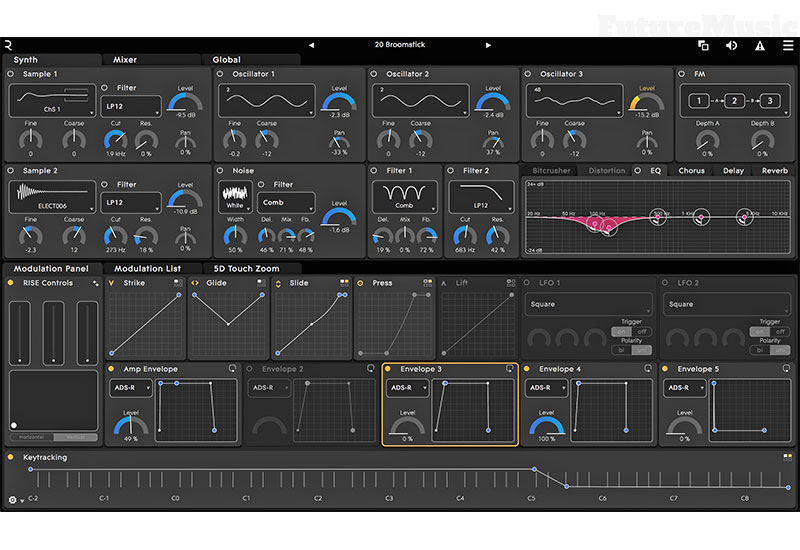
Equator was developed in conjunction with the Rise. Although the Rise can be used with other soft synths through a middle-ware solution that is “pretty rough around the edges,” right now we only have Equator to show off the Five Dimensions Of Sound. Considering the ecstatic response the Rise received, Equator, unfortunately, lost points with most of our reviewers. It wasn’t with the graphical user interface or the synths usability (although “creating patches from scratch could certainly use some work.” see below) “For a 1.0 version of a synth, I think Roli knocked it out of the park with the simple, yet very usable interface, visual drop downs and the minimal vector aesthetic,” noted an evaluator. Equator has everything you need on its single page, no need to delve into multiple screens, no obtrusive pop-ups, and no deep menus. The caveat?
“Equator has a very brittle, very digital sound signature that may work well with modern genres, but leaves more traditional musicians out in the cold.” Presets and patches that we tested in our SoundLab worked best when sitting solidly in the mid-range, however when expanded into the low-end, the bass lacked “roundness and tubbiness” you need to “really move air.” Moving into the upper registers, caused even more problems. “The high-end, basically anything above 6K, was just too biting for me. Sounds quickly distorted and it felt like I was being bombarded by ice shards.” With some of today’s ear-piercing electronic genres, this can certainly be desirable, but when working in this realm, “ear-fatigue became a major issue.”
Patch creation is also not Equator’s strong suit. For users who really want to get under the hood of the synth, it’s “surprisingly wonky.” Worse, when you do save a patch you’ve created, or even modded one of the existing 128 presets, the result “often doesn’t save accurately.” And every evaluator noticed that Equator is a “glutton for memory,” often hogging over 50% of a computers bandwidth.
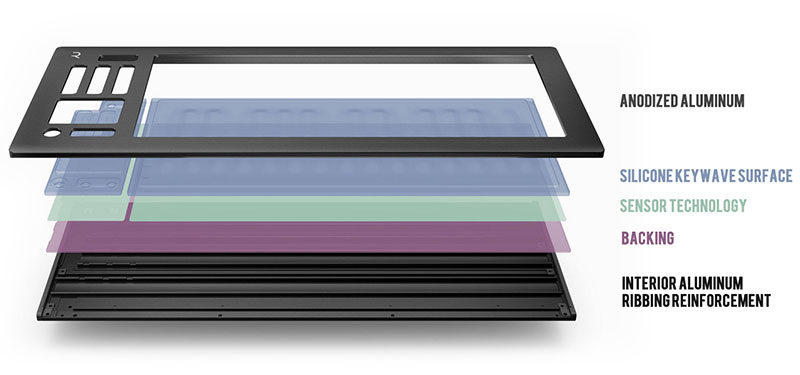
When many manufacturers develop an entry-level version of their flagship products, they normally cut corners in features, materials and other areas to meet a price point. Roli took the complete opposite approach with Rise. The build quality of the Rise is simply “world-class.” It stands only 23mm tall, but the black anodized aluminum chassis “looks like it will be the only thing that survives a nuclear apocalypse, along with the cockroaches, of course.” It’s substantial weight makes you think twice about real world portability, but our reviewers found it strikes the perfect balance between robust and cartable. “The Rise looks like it can really take a beating. I certainly don’t mind the extra weight, knowing that one knock won’t shatter it into a million pieces, like typical controllers from Akai and M-Audio.”
The Seaboard Rise can also be played wirelessly via built-in Bluetooth and an internal battery, which lasted over ten hours in our SoundLab. The MIDI over Bluetooth technology receives MIDI signals when paired to Bluetooth-enabled devices. It worked flawlessly for our reviewers and “has imperceptible latency” compared to hard-wiring it via USB. For gigging musicians, the wireless ability allows you to take the Rise to the front of the stage for a big solo without having to pretend your a guitarist. Buskers will appreciate the ability to leave the computer next to the sound system so the audience can focus on the performance. For composers on the go, simply connect the Seaboard Rise to Roli’s new Noise iOS app, and let inspiration take you away without being encumbered by wires or a computer. “Incorporating MIDI over Bluetooth was a clever decision that sends the Rise into the ‘sixth dimension’ of sound! Just awesome!”
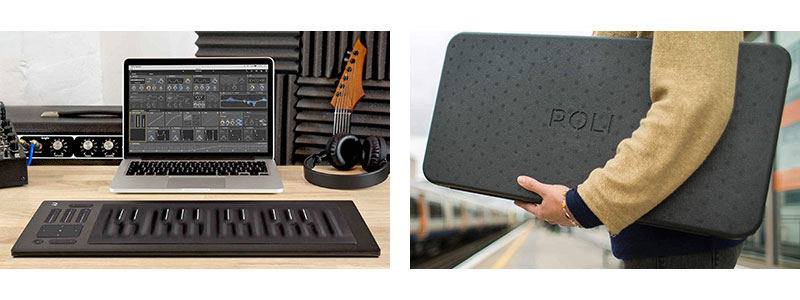
Recording to a Digital Audio Workstation (DAW) was a perplexing experience for our uninitiated reviewers. In order to capture all the glorious extra expression provided by the Roli, it needs to simultaneously record on 10 MIDI channels at once, using a new blueprint dubbed, Multidimensional Polyphonic Expression (MPE), which Roli initiated at last year’s NAMM show in Anaheim, California. Roli reached out to several forward-thinking companies prior to the event and eighteen concerns signed on to be a part of the new industry-wide specification, including Moog, Linn, Bitwig, Keith McMillen Instruments, Steinberg and Apple. The spec created a methodology for routing multiple MIDI channels in the background. Right now only Apple’s Logic and Steinberg’s Cubase are “supported” and setup can “be an exercise in patience,” but it is possible to record and recall your performances on the Rise. Once development of MPE matures and more companies sign on, the availability of “MPE-Ready” products on the market could be the tipping point in order to make Roli and MPE a force in the market.
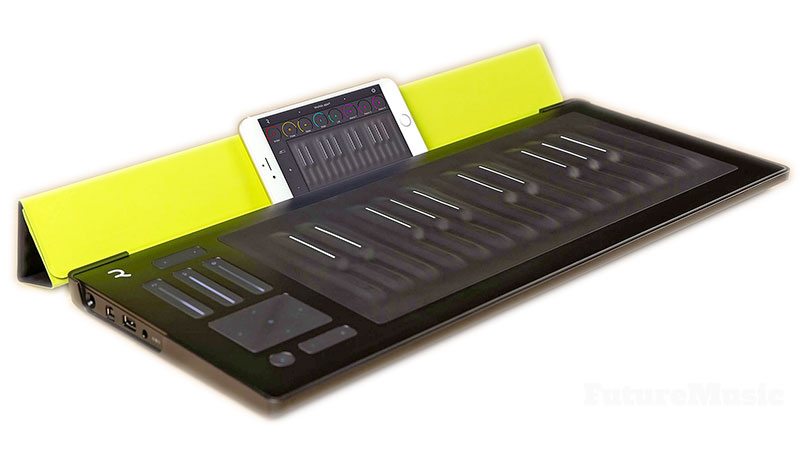
What’s With The Noise?
In addition to extensively testing the Rise, we also had the opportunity to evaluate Roli’s new iOS synth app, Noise. Noise is basically an Equator Player made to wirelessly connect to the Rise over Bluetooth and provide a sound source for performing on the move. However, what sets Noise apart is that Roli has incorporated Apple’s haptic, 3D Touch technology into the app, allowing Noise to have the same 5 Dimensions of Sound. Strike, Glide, Slide, Press and Lift is all included and we are pleased to report it works very well, keeping in mind you’re playing a hard surface.
The interface is pretty straightforward, but initially “finding a patch takes a moment to figure out how to access the preset menu.” You’ll find many of the same presets from Equator, 25 in all, and you can download addition SoundPacks. The virtual keywave keyboard is quite playable, considering we were testing the app out on the iPhone 6S (not the bigger Plus model), but the real action happens when you sync it to a Rise. Now you have a real Roli ecosystem in play, and the potential becomes apparent.
For Roli, the best aspect of the Noise app is for marketing. As a free download in the Apple App store, nothing showcases the Roli concept better. In fact, if you’re intrigued by our review, and have a Apple iPhone 6S or 6S Plus, download the app now and try it for yourself.
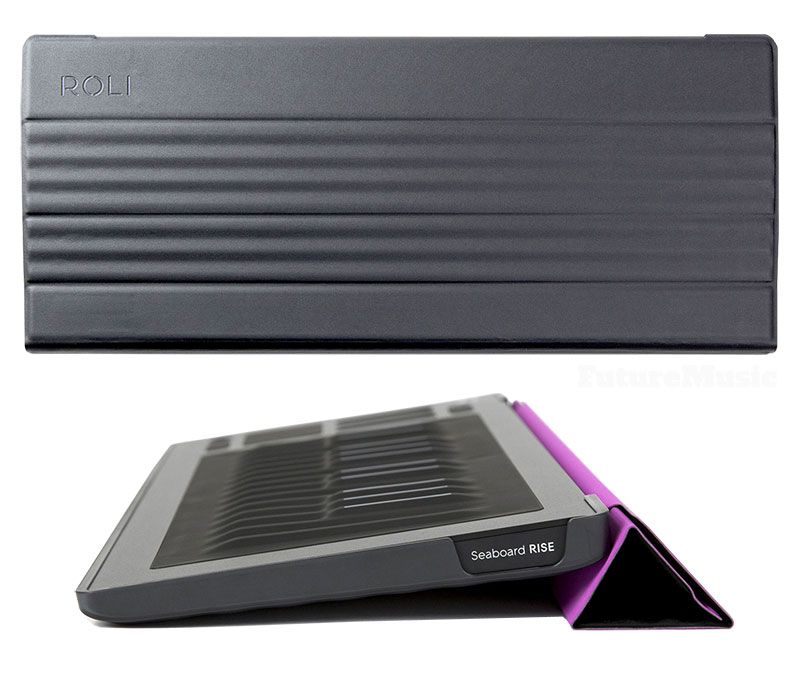
The other accessory provided to us by Roli was their fine FlipCase. The design is an obvious bite of Apple’s magnetic, folding iPad cover, but it works very well to protect the soft keywaves, as well as provide a plastic bumper around the outside to insure the Rise’s chassis. Similar to the iPad’s case, the folding aspect allows a user to create a folded triangle underneath the unit for a angled playing surface. The case comes in five pastel colors, silver, sky (blue), lime, amber and our reviewers favorite, lilac, a deep purple. It’s very well executed, and if you’re thinking about buying the Rise, definitely spring for the case.
Conclusion
If you couldn’t tell already from our extensive test, we think the world of the Roli Seaboard Rise. In fact, it’s on the short list for the FutureMusic 2015 Product Of The Year. Although it does have some shortcomings, they are all on the software side of the equation, which can be addressed with subsequent updates. The difficult part was nailing the hardware, and Roli genuinely delivered. Beyond the product itself, the company, spearheaded by Roland Lamb, is fueled by passionate and intelligent individuals who put a lot of deep thought into every decision they make, and it really shows.
What elevates the Roli Seaboard Rise above all other “new instrument” concepts that have appeared over the years is the astute idea of not having to learn a new instrument from scratch. Compare the Seaboard Rise to an inane offering like the Artiphon, and the competitive advantage is glaring and unmistakable. There have been many attempts to drag the “ancient” MIDI protocol into the new millennium, and even more to update the piano interface without success, but the Roli Seaboard Rise just might achieve the impossible. Highly Recommended.
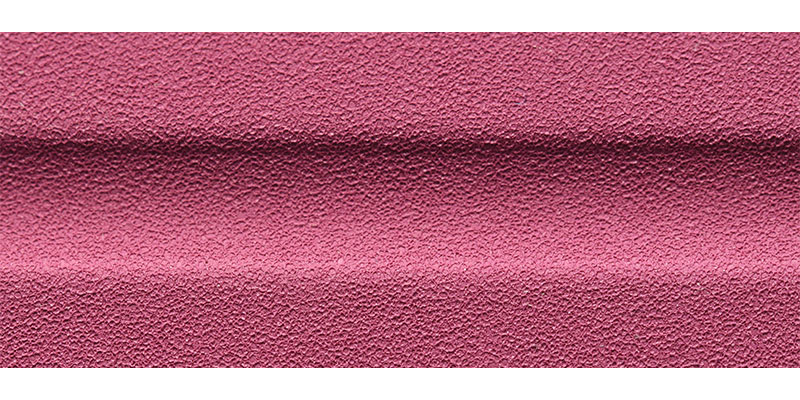
The Future
While the Rise is being recognized as a truly innovative bit of kit, it’s all about Roli being quite proactive on both the software and hardware fronts beyond their own products. Forging relationships now with popular soft-synths to make them MPE-Ready is paramount, considering the current sonic and feature-limitations of Equator. While many hardware manufacturers are part of the MPE Consortium, many of the soft-synth leaders are not involved. Native Instruments comes to mind as a company the alliance should have on-board, since a MPE-ready Massive would be a very compelling proposition to EDM producers who have developed a deep bond with the synth. However, smaller concerns, think Lennard Addink with his Sylenth 1, should also be vigorously approached.
On the hardware front, licensing agreements, or even collaborative partnerships with visionaries such as Dave Smith should also be on the table. Modular synthesis could also be a ripe opportunity. One of the first things that David Phipps, the talented keyboardist from Sound Tribe Sector 9, stated when we showed him the Roli Rise backstage prior to a performance, was “this thing should have CV outputs on the back.”
FutureMusic Rating: 91%
Cheers:
+ Innovative
+ Build Quality
+ Bluetooth Connectivity
+ Noise App
+ Protective Case
Jeers:
– Memory Hog
– Equator Needs Work

Roli’s Seaboard Rise costs $799 and is available now.
Roli






